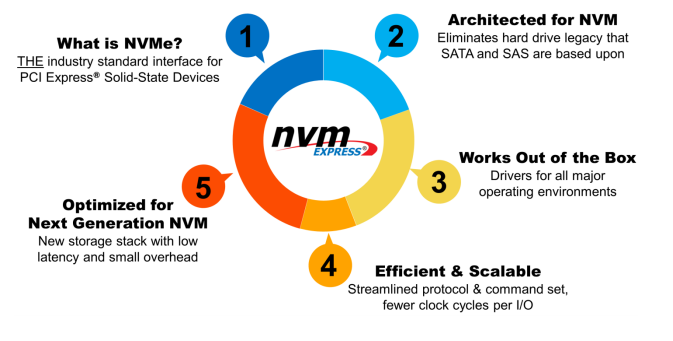Nowadays, Data is new fuel for businesses. New age technologies like Artificial Intelligence, Internet of Things, Blockchain, Machine Learning, all need data to be stored, processed and analyzed. Large amount of data is generated exponentially with a rise in the internet users in last 7-8 years. According to ‘Data never Sleeps’ report, 2.5 quintillion bytes of data is generated every day. Currently, internet users are 47% of the internet population, representing 3.8 billion active internet users. A report estimated that by 2020, 1.7 MB data will be generated by every internet user on earth.
This data tsunami puts forth challenges for IT infrastructure to provide low latency and higher storage performance as most of the enterprises need real-time data processing and faster access to stored data. Access to high-performance SSDs using legacy storage protocols like SATA or SAS are not enough as they still have higher latency, lower performance, and quality issues.
NVMe enabled storage infrastructure
NVMe is a high-performance scalable host controller interface protocol that is needed to access high-performance storage media like SSDs over PCI bus. NVMe is the next generation technology which is replacing SATA and SAS protocols and offering features required by enterprises that focus on processing high volume real-time data. The main differentiator in NVMe, SATA, and SAS is the number of commands supported in a single queue. SATA devices support 32 commands, SAS supports 256 commands and NVMe supports up to 64K commands per queue and up to 64K queues. Queues are designed to take advantage of parallel processing capabilities of multi-core processors.

NVMe protocol is characterized by the fact that existing applications are getting accelerated and enabled by real-time workload processing within NVMe enabled infrastructure. Infrastructure can be a legacy data center or at an edge. Such performance is achieved as NVMe consumes very fewer CPU cycles as compared to SATA or SAS where CPU consumption is on a higher side. This feature allows businesses to get maximum returns from their existing IT infrastructure.

NVMe based infrastructure for IoT Workloads
NVMe based systems will be the key element in processing IoT and Machine Learning workloads.
Multiple sensors that stream generated data at a faster rate and need to push into databases require a higher bandwidth. Also, consumed data need to get processed and analysed at higher computing rate and return back to devices with analysed data. This entire operation needs high performance and low latency network plus storage ecosystem to respond at an equal rate as the network. NVMe over fabrics can be used with IoT use cases that utilize message-based commands to transfer data between a system and a target SSDs or system over a network(Ethernet, Fibre Channel or InfiniBand).
Conclusion
Any enterprise using SSDs will get benefited from the application of NVMe protocol. NVMe based infrastructure will be ideal for use cases representing SQL/NoSQL databases, real-time analytics, high-performance computing (HPC). NVMe enables new applications for machine learning, IoT databases, and analytics; real-time application performance monitoring and security audits. NVMe offers scalable performance and low latency options that optimize the storage stack. NVMe is architected to take full advantage of multi-core CPUs which will drive rapid proliferation in technology advancement in upcoming years.
References
http://www.nvmexpress.org/wp-content/uploads/NVMe_Overview.pdf
[Tweet “Why NVMe is Important for New Age Data Center Workloads?~ via @CalsoftInc”]






